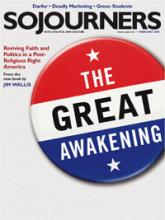Growing a solution to hunger is what farming has always been about, but the Foods Resource Bank has taken that old tradition and connected it to addressing the world’s hunger problem in a new way. The organization partners U.S. farmers in rural churches with city churches to literally “grow” a response.
In more than 200 projects across the country, communities are raising crops and livestock to use the productive power of agriculture to raise money for the world’s poorest people. It is an entrepreneurial pursuit, not just a fundraiser. Each growing project takes land, labor, seeds, and implements and puts them to work to make the money needed to fund sustainable development in the global South.
Take as an example the Foods Resource Bank growing project in Archbold, Ohio. Cattle farmer Corwin Rufenacht saw a video at his church about Foods Resource Bank (or FRB) and thought about all of the empty barns in his community. Like much of rural America, his area has a declining numbers of farmers, a trend that has seen a more than 70 percent reduction in the number of farms since a peak of 6.8 million in 1935 (the reduction is due to reasons that include suburban sprawl and ever-more engineered production techniques that favor farm consolidation). There was land available and barns being unused. “Why don’t we do a project with beef,” Rufenacht thought.
Read the Full Article
